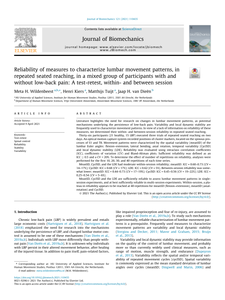Literature highlights the need for research on changes in lumbar movement patterns, as potential mechanisms underlying the persistence of low-back pain. Variability and local dynamic stability are frequently used to characterize movement patterns. In view of a lack of information on reliability of these measures, we determined their within- and between-session reliability in repeated seated reaching. Thirty-six participants (21 healthy, 15 LBP) executed three trials of repeated seated reaching on two days. An optical motion capture system recorded positions of cluster markers, located on the spinous processes of S1 and T8. Movement patterns were characterized by the spatial variability (meanSD) of the lumbar Euler angles: flexion–extension, lateral bending, axial rotation, temporal variability (CyclSD) and local dynamic stability (LDE). Reliability was evaluated using intraclass correlation coefficients (ICC), coefficients of variation (CV) and Bland-Altman plots. Sufficient reliability was defined as an ICC ≥ 0.5 and a CV < 20%. To determine the effect of number of repetitions on reliability, analyses were performed for the first 10, 20, 30, and 40 repetitions of each time series. MeanSD, CyclSD, and the LDE had moderate within-session reliability; meanSD: ICC = 0.60–0.73 (CV = 14–17%); CyclSD: ICC = 0.68 (CV = 17%); LDE: ICC = 0.62 (CV = 5%). Between-session reliability was somewhat lower; meanSD: ICC = 0.44–0.73 (CV = 17–19%); CyclSD: ICC = 0.45–0.56 (CV = 19–22%); LDE: ICC = 0.25–0.54 (CV = 5–6%). MeanSD, CyclSD and the LDE are sufficiently reliable to assess lumbar movement patterns in single-session experiments, and at best sufficiently reliable in multi-session experiments. Within-session, a plateau in reliability appears to be reached at 40 repetitions for meanSD (flexion–extension), meanSD (axial-rotation) and CyclSD.
MULTIFILE

Achtergrond: Ernstige psychische aandoeningen (epa) gaan gepaard met hoge ggz- en andere zorgkosten. Om de discussie hierover tussen verzekeraars, gemeenten en ggz transparanter te voeren zijn in 2012 zorgvignetten ontwikkeld die in een regio een beeld moeten geven over de aanwezige groepen patiënten met epa, ingedeeld naar zorgintensiteit. Doel: Inzicht krijgen in de vraag hoe bruikbaar en valide deze epa-vignetten zijn in relatie tot zorgbehoeften en psychosociaal functioneren. Methode: rom-uitkomsten (zorgbehoeften en psychosociaal functioneren) van 706 patiënten werden per zorgzwaartevignet vergeleken (m.b.v. χ2-toetsen en anova’s). Voor twee complexe zorgzwaartevignetten (zorgwekkende zorgmijders en gevaar afwenden) werden verschillen in zorgbehoeften en functioneren longitudinaal onderzocht (met repeated measures-anova’s en analyses volgens McNemar). Resultaten: De vignetten waren in beperkte mate onderscheidend wat betreft zorgbehoeften en functioneren. Patiënten met vignetten ‘zorgwekkende zorgmijders’ en ‘gevaar afwenden’ hadden de meeste beperkingen in functioneren en de meeste (onvervulde) zorgbehoeften. Deze bevindingen bleken stabiel over tijd. Conclusie: De vignetten zijn onvoldoende onderscheidend. Om regionale zorgplanning te verbeteren is het wenselijk om bestaande informatie van zorgvignetten te verrijken met informatie over zorgbehoeften en functioneren
DOCUMENT

Factors affecting repeated sprint ability (RSA) were evaluated in a mixed-longitudinal sample of 48 elite basketball players 14 to 19 years of age (16.1±1.7 years). Players were observed on six occasions during the 2008-2009 and 2009-2010 seasons. Three basketball-specific field tests were administered on each occasion: the Shuttle Sprint Test (SST) for RSA, the Vertical Jump (VJ) for lower body explosive strength (power), and the Interval Shuttle Run Test (ISRT) for interval endurance capacity. Height and weight were measured; body composition was estimated (percent fat, lean body mass). Multilevel modeling of RSA development curve was used with 32 players (16.0±1.7 years) who had two or more observations. The 16 players (16.1±1.8 years) measured on only one occasion were used as a control group to evaluate the appropriateness of the model. Age, lower body explosive strength, and interval endurance capacity significantly contributed to RSA (p < .05). RSA improved with age from 14-17 years (p < .05) and reached a plateau at 17-19 years. Predicted RSA did not significantly differ from measured RSA in the control group (p > .05). The results suggest a potentially important role for the training of lower body explosive strength and interval endurance capacity in the development of RSA among youth basketball players. Age-specific reference values for RSA of youth players may assist basketball coaches in setting appropriate goals for individual players.
LINK
Develop a maturity model based on a quick scan to see how far a (SME) company is in awareness / activities on sustainable logistics (and the direction to zero emission city logistics: ZECL ) and (if it is possible, because this is a 2nd model) how far governments are in their ZE zone planning. Based on the quick scan, companies receive appropriate information about their relevant policy and sustainability measures (including availability of e-vehicles, etc.). Tool can be used by students to quickly reach companies around ZECL and to provide them with information directly via the results. This helps and students learn about this subject, but should also contribute to awareness among a larger group of feeding/receiving and possibly loading parties about ZECL. In addition, with sufficiently participating companies, a good picture can also arise of how far companies are now with regard to ZECL (and this could also be repeated over time in order to get a picture of the development in maturity in this area).